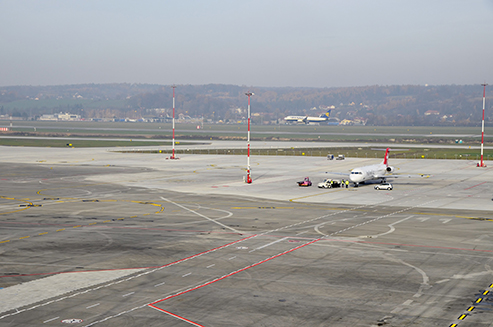The general contractor was the consortium consisting of Max Bögl Polska Sp. z o.o. (Consortium Leader) and Max Bögl Stifung&Co. KG (Consortium Partner). The substitute investor was Safege S.A.S.
The works started in April 2013 and were done in stages, with no interruptions and limitations in the air traffic. Conducting works while the airport was operating was a huge challenge for all the airport services, including the airport staff who manage the airport infrastructure on daily basis – stresses Jan Pamuła, President at the Kraków Airport.
By expanding the apron, the number of parking spaces has been increased by five so that 22 aircrafts with the C reference code (e.g.: Boeing 737-800) can be parked at the same time. Four co-funded parking places are located in the north-eastern part (previous military sewage disposal plant) and the remaining ones – next to the technical and administration building. Technology used in constructing the new part of the apron allowed us to achieve very high load-bearing capacity of the surface. The laboratory studies conducted together with the Air Force Institute of Technology prove that millions of air operations can be performed here – says Łukasz Susło, Contract Deputy Director at Max Bögl Polska Sp. z o.o. After the expansion, the layout of the apron has also changed and all the positions offer more space, which facilitates handling and refuelling aircrafts in the parking position. Along with completing future stages of the investment at the terminal, the Kraków Airport will be able to receive more large aircrafts with the E and D reference code, such as Boeing 787 Dreamliner or Boeing 747.
The modernisation works also included the reconstruction of Alfa, Bravo, Julliet, Golf and Fokstrot taxiways as well as the extension of the Charlie taxiway. The electrical grids in the operational area and navigation lights in the taxiways have been significantly developed. The investment also consisted in equipping the reconstructed taxiways with axial lighting steered from the new system with individual control panels as well as replacing the source of edge lighting with LED lights. Moreover, the rainwater harvesting system has been modernised and developed. The airport surfaces have been equipped with new drainage troughs and four water storage reservoirs have been built (ca. 650 cubic metres each).
All the works aimed at improving the safety of airport operations and increasing the load-bearing capacity of the airport surface. At the moment we can receive heavier aircrafts – informs Jan Pamuła – With the new edge lighting, axial lighting and stop bars aircrafts can move around the handling area at the Kraków Airport much easier and safer, especially with limited visibility.
The Kraków Airport – Existing Infrastructure Development Project also involved completing the bridge between the apron and the taxiway in 2011. The general contractor at that stage was Warbud S.A.
Investments completed by Max Bögl Polska Sp. z o.o. in numbers:
– 156,660 square metres of concrete surfaces (more than 10,000 trucks which, arranged in a line, would make a 130 km-long queue)
– 47,680 tons of concrete (100 tank cars which, arranged in a line, would make a 30 km-long queue)
– 55,600 tons of Dolomite chips (more than 2,220 trucks) and 84,300 tons of granite chips (more than 3,370 trucks)
The value of works executed by Max Bögl Polska Sp. z o.o. is 161.4 million PLN gross, while the total cost of investments realised within the EU project in the operational area is 200.84 million PLN gross. The works were financed from the company’s own funds, bonds and EU funds. The subsidy amounted to 76.04 million PLN.
Official website: Kraków Airport
Photo © Kraków Airport


